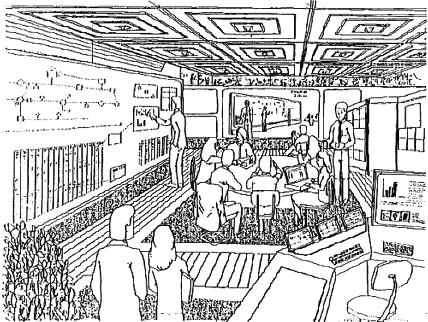The Artful Integration of
Processes Tools and Environments

Description of this Environment
 This is a sketch is our 1982 “THERE” - it expresses the environment, technology, process vision that we have been “bringing HERE from THERE” since the formation of our enterprise. Everything that we do, every exercise, every event, every deployment every build-out, is done in context to this goal.
This is a sketch is our 1982 “THERE” - it expresses the environment, technology, process vision that we have been “bringing HERE from THERE” since the formation of our enterprise. Everything that we do, every exercise, every event, every deployment every build-out, is done in context to this goal.
Each cycle of work we want to know: how can we best make and use this environment to support our clients and what can we learn about it - to do better next time.
Basically, our work is single focussed: we create, with each iteration of work, the best future environment we can and then invite customer/users/clients, as well as, investors and producers - the entire ValueWeb - into this environment to create and recreate themselves and their organizations. This is true if the activity is a DesignShop, a retail customer in a KnOwhere store, a client building and using a NavCenter.
It is our experience that the future cannot be usefully conceived from the frame of the present. It has to be designed and engineered from a “good enough” version of itself. Our entire process and tool kit - and the environments that house them - is based on this premise. Our IP is based on this practice.
Today, we do the process shown in the above sketch/vision by a mostly labor intensive process employing many KnowledgeWorkers. We support it with off-the-shelf technology that partially fits the task. In time, as the CyberConn technology tool-kit is developed, the KnowledgeWorkers will be able to “trade up” to more value-added work. However, this present level of effort is worth it for several reasons:
We are learning and practicing the algorithms that will make up the deep processes of this technical system;
This is how we educate/train our KnowledgeWorkers in the basics of the process;
The results we get now are well worth the work.
We do the 10 Step Process now - however crudely. We are boot strapping our way to the system we want by bringing THERE to HERE every way we can - every day. This is employing our methods to create our methods.
The NavCenter physical environment has evolved into a complete floor-to-ceiling, wall-to-wall system that makes a complete environment for the user.
The integration of work processes, cybernetic tools and dynamic environments is more than integration of the existing versions of these elements. Just integration of the “what is” is useful but not sufficient. Each of these components have to be redesigned in context of their integration to the other components and the whole system that emerges out of this process.
This is why, when we created MG Taylor, we made it a for profit business. We knew that we has to demonstrate market utility each step of the way. We never let the market dictate what we built and offered - we did, however, require of ourselves that what we wanted to bring to the world was sufficiently practical so that people would pay us enough to stay in operation. On three occasions we came close to going under. Only once (the first crises three years into our experience), however, was this related to lack of market acceptance.
Palo Alto
March 25, 1999
posted March 25, 1998
revised June 26, 1999
note: this document is about 15% finished
DesignShop, NavCenter RadiantWall, WorkWall, RemotePresence, CyberConn are Trademarks of iterations and licensed to MG Taylor Corporation.
Aspects of the system and method described are Patent Pending.